HW 10 -- POMDPs and Bandits
Please Log In for full access to the web site.
Note that this link will take you to an external site (https://shimmer.mit.edu) to authenticate, and then you will be redirected back to this page.
No coding questions for the final HW!
Recall the Robot Charger POMDP from last HW and from lecture. We will be exploring the belief simplex of the POMDP in problems 1 and 2.
1) Belief Simplex§
In this section we will discuss a useful representation for visualizing a set of beliefs, called the "Belief Simplex".
Specifically, the set of possible belief states over K world states is a simplex, which is a K-1 dimensional manifold (surface) embedded in the K dimensional space. In our case where K = 3, we can visualize a belief space in a 3D plot. In the following simplex visualizations, you will see green areas covering part of the belief space, which indicates the set.
The figure above shows an illustration of what a simplex looks like in 3D. You can find more details on this Wikipedia Page. Figure credit: blog.bogatron.net.
-
For each of the following belief states, explain what part of the simplex it corresponds to.
-
b(s = 0) = 1
-
b(s = 0) = 0
-
b(s = 0) > p
-
b(s = 0) = b(s = 1)
-
-
Which of the following plots corresponds to belief states in which the value of charging is greater than 0?
A 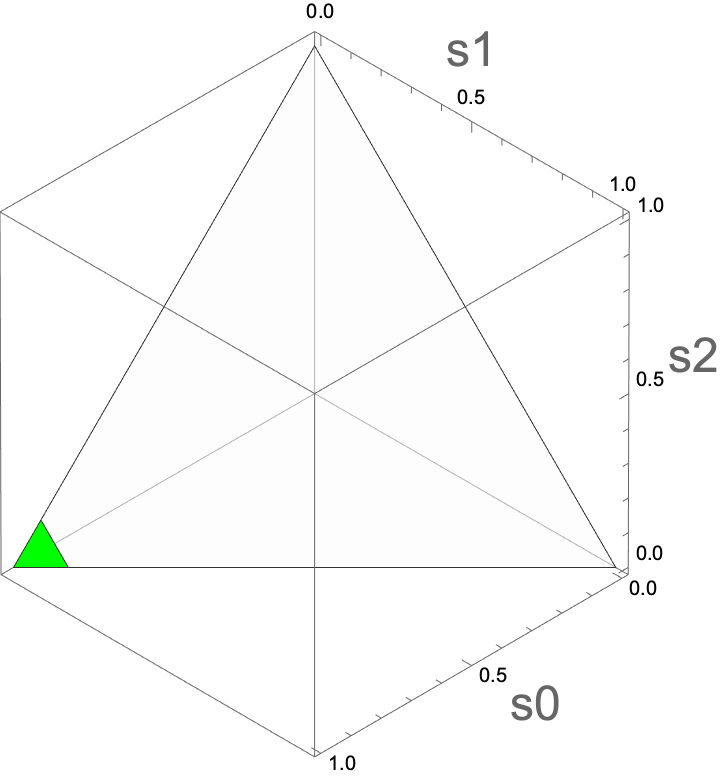
B 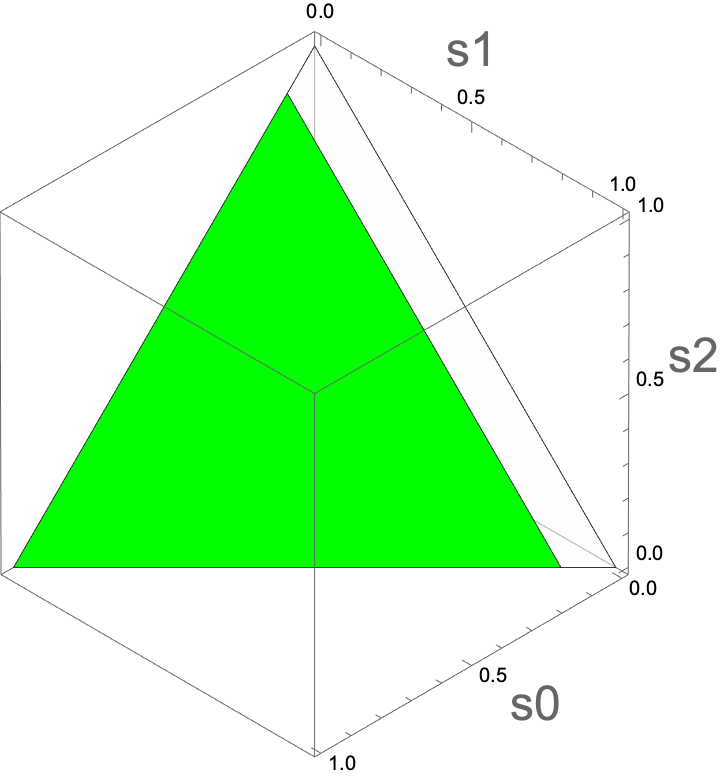
C 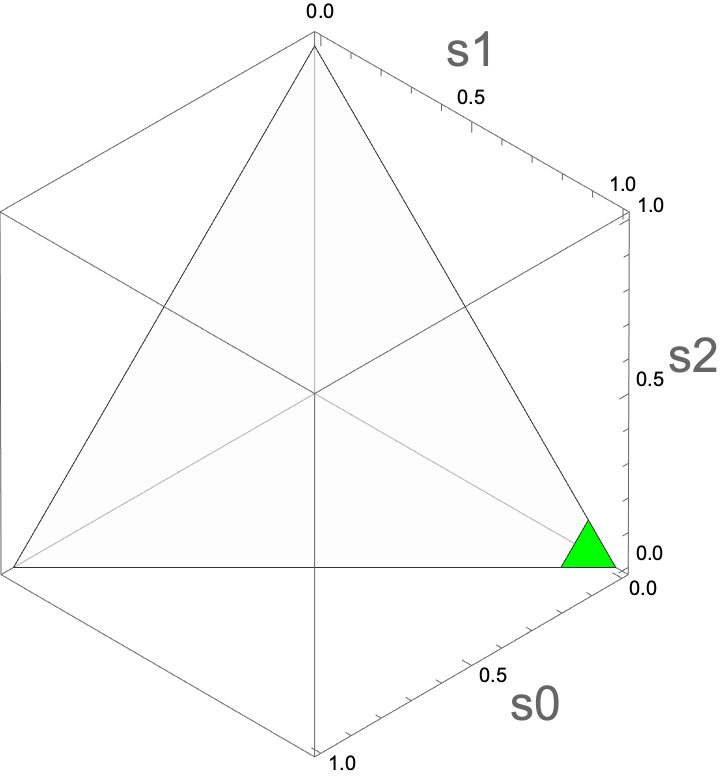
D 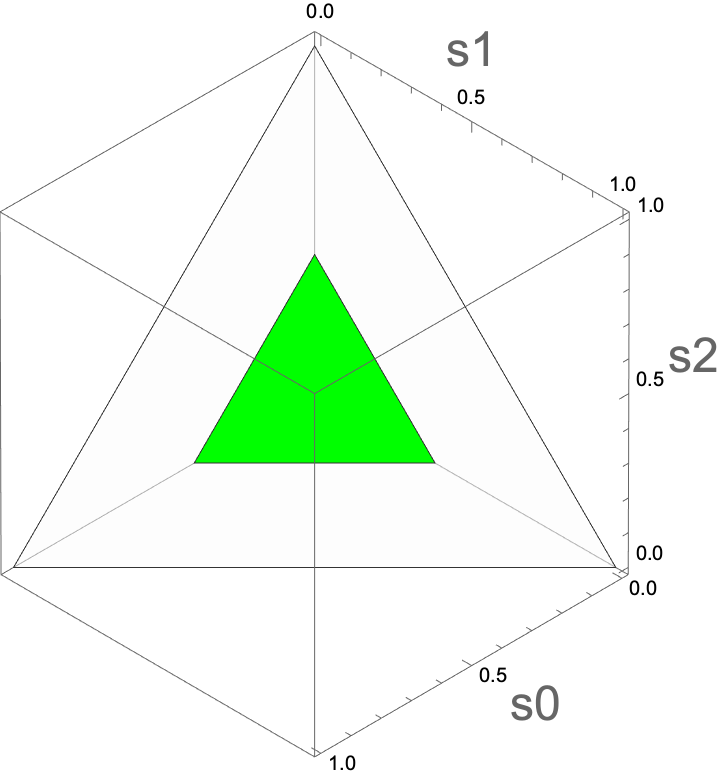
Select the simplex in which the value of charging is greater than 0.
Pick one.
2) Optimal Solution§
2.1) Exponential^Exponential§
In general, consider a Partially-Observable Markov Decision Process (POMDP) with action space \mathcal{A} and observation space \mathcal{Z} with horizon h. One way to compute the "optimal" strategy for solving the POMDP is to build a "policy tree". Denote A = |\mathcal{A}| and Z = |\mathcal{O}|.
-
What's the size of the policy tree of horizon h?
O(A^h) O(Z^h) O((AZ)^h) O(A^{(Z^h)}) -
How many possible policy trees of horizon h are there?
O(A^h) O(Z^h) O((AZ)^h) O(A^{(Z^h)}) -
Are there any algorithms for solving POMDPs optimally with a better worst-case complexity than a SPA (Stupidest Possible Algorithm)?
Yes! :-) No... :-(
2.2) Belief Simplex Visualization of Optimal Policies§
Here are four plots showing the optimal finite-horizon policies with \gamma = 1.0 for horizons H = 1, 2, 3, 4. The colors correspond to actions:
- Green: look(0)
- Magenta: look(1)
- Cyan: look(2)
- Red: move(0, 1)
- Blue: move(1, 2)
- Orange: move(2, 0)
- Brown: charge
- Grey: nop
| H=1 | 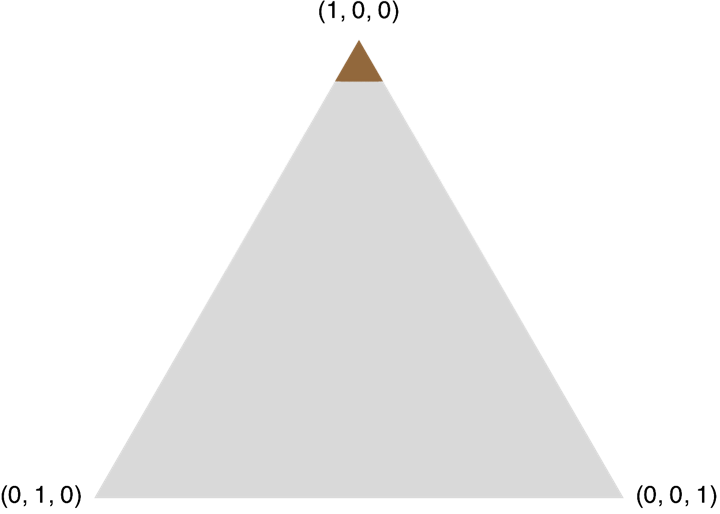 |
H=2 | 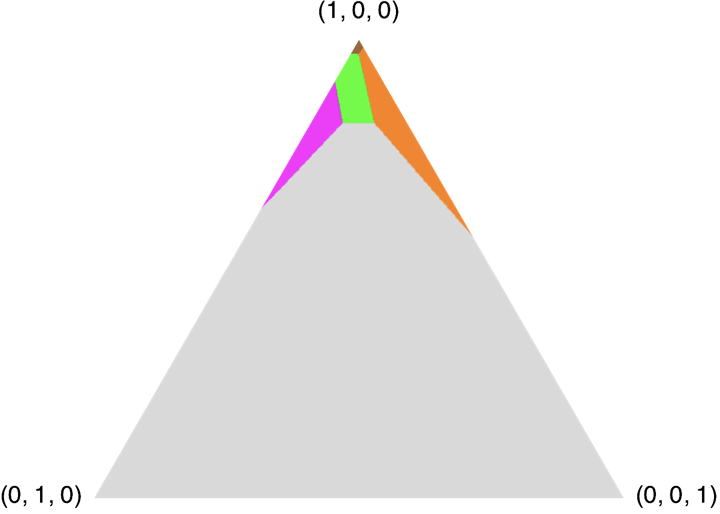 |
| H=3 | 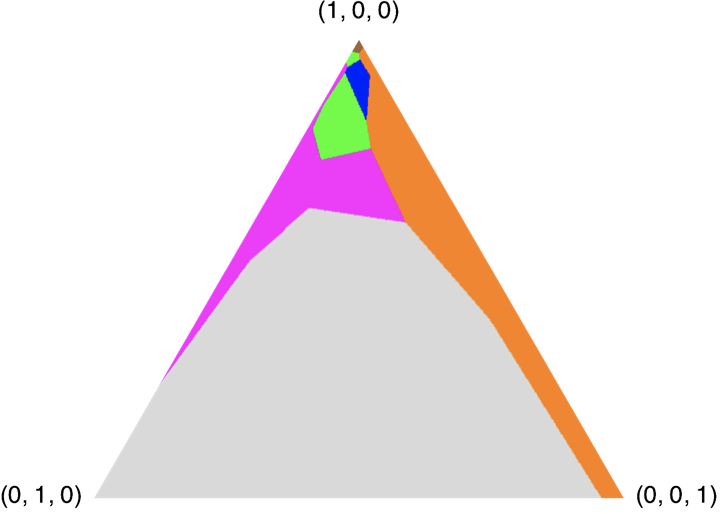 |
H=4 | 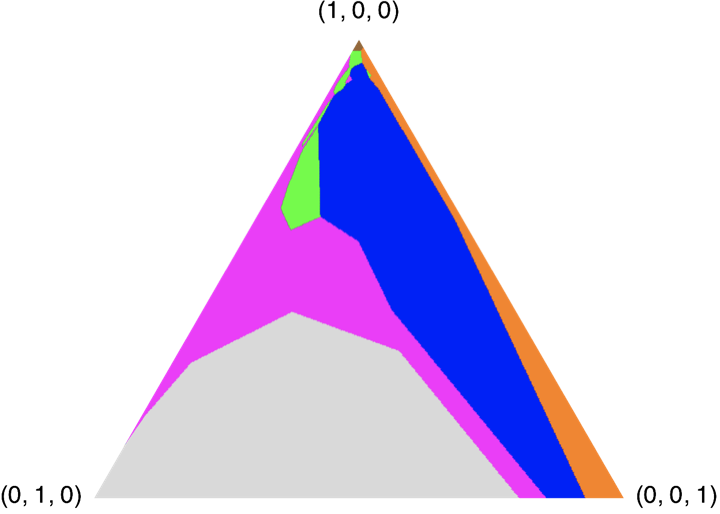 |
Note: Red and cyan have never appeared in the figures above, but they may appear in figures showing the optimal policies for longer horizons.
-
The horizon 2 policy has 5 regions. In which regions are we guaranteed to charge on this step or the next one? (Hint: look at the simplex, and use your intuition about the workings of the charge POMDP.)
Mark all colors that apply.Brown Green Magenta Orange Grey -
The horizon 2 policy has 5 regions. In which regions will we charge on the next step if we get observation 1 on this step?
Mark all colors that apply.Brown Green Magenta Orange Grey -
In the horizon 2 policy, there are fewer belief states when we want to charge than there are in the horizon 1. Why?
Mark all reasons that apply.Because discounting makes charging less attractive now Because we have time to increase our belief that the charger is in location 0 Because we lose information over time -
Is it true that, in the horizon 2 policy, for all the gray belief states, there is no possible observation that would put us in the brown region of the horizon 1 policy?
Enter True or False.True False -
If we were to decrease the cost for looking, would the magenta region in the horizon 2 policy be bigger, smaller, or the same?
Mark the change to the magenta region.Bigger Smaller Same
3) Sparse Sampling Theory§
Proving an error bound on the sparse sampling algorithm is beyond our scope, but let’s consider a simpler case, with horizon 1. So, really, we are interested in a contextual bandit problem.
- We find ourselves in a state s.
- There are only two actions.
Normally, we would compute Q(s, a) = \sum_{s'} R(s, a, s') P(s' | s, a) for each action and select the action with the largest expected reward. But what if the number of possible next states is so large that we can’t afford to compute Q? We can draw n samples s'_i \sim P( \cdot | s, a), where i=1,2,\cdots,n and estimate
\hat{Q}(s, a) = \frac{1}{n} \sum_{i=1}^n R(s, a, s'_i).
Assume that 0 < R(s, a, s’) < \mathrm{Rmax} for all s, a, s’. Let's think about how far wrong our estimate \hat{Q} can be from the true Q value.
Note that we're developing the general case, but for your answers in this question, you can assume that \mathrm{Rmax} = 1.
Chernoff and Hoeffding to the rescue! The idea of tail bounds from probability, which tell us (assuming independent samples) how the quality of our estimates depends on the size of the sample set. One version of their bound, applied to our problem, says that if we estimate \hat{Q} as above, then
P(|\hat{Q}(s, a) - Q(s, a)| \ge \epsilon) \le 2 \exp(-2n\epsilon^2 / \mathrm{Rmax}^2).
-
What's the upper bound for Q(s, a) for all s and a?
Please input your answer as a number.
-
You want to be at least 95% sure that your \hat{Q} estimates differ from the correct value by at most 0.1, how many samples would you need to take (at least)?
Please input your answer as a single integer.
-
How does the required number of samples, n, change if the size of state space S increases?
Increase Decrease Not Change -
What will happen to n if you want your estimates to differ from the correct value by at most 0.01 with probability 95%?
Increase by a factor of 10 Increase by a factor of 100 Increase by a factor of 1000 Decrease by a factor of 10 Decrease by a factor of 100 Decrease by a factor of 1000 Not Change -
How does n roughly change by (relative to part 4) if you want to be 99% sure your estimates differ from the correct value by at most 0.01?
Increase by a factor of 2 Increase by a factor of 10 Decrease by a factor of 2 Decrease by a factor of 10 Not Change
4) Bandit§
-
Recall the
super-simplebandit problem from lecture. There are K arms with binary reward. For each arm i, the probability of payoff is randomly picked to be one of \{0.1, 0.5, 0.9\}. In the super-simple bandit example, which of the following priors would mean that we couldn't maintain a factored belief representation?For each arm, P(p_i = .1) = .8, P(p_i = .5) = .1, P(p_i = .9) = .1 We know that all the arms are identical to each other, so with probability 1/3 all p_i=.1, with probability 1/3 all p_i=.5, and with probability 1/3 all p_i=.9 One arm has the prior P(p_i = .1) = .5, P(p_i = .5) = .5. For other arms, P(p_i = .1) = .8, P(p_i = .5) = .1, P(p_i = .9) = .1 -
What would happen if we tried using the most-likely observation determinization on a Bernoulli bandit problem?
Mark all that are true.It actually wouldn't apply because the underlying POMDP state space is infinite. Assuming there are only two arms, it would always make one of two plans: always pick right arm or always pick left arm. It would behave the same way as always picking the arm with the most total successes. It would behave the same way as always picking the arm with the highest ratio of \alpha / (\alpha + \beta) where \alpha, \beta are the parameters of the posterior beta distribution. -
What is the best known upper bound on the regret, as a function of trial length N, of the following K-arm bandit strategies?
Thompson samplingO(1) O(\log N) O(\sqrt{N}) O(N) UCB strategy that picks the arm with maximum \hat{\mu_i} + \sqrt{\frac{2 \log(1 + N \log^2 N)}{N_i}}O(1) O(\log N) O(\sqrt{N}) O(N) -
Consider the two-arm bandit problem where the mean reward for each arm is drawn uniformly from [0, 1]. Compute the exact regret of the following strategies over n actions.
Picking an arm at random and sticking with it the whole time. Compute the exact regret, not the asymptotic. Write your expression in terms ofn.
Picking an arm at random on each step. Compute the exact regret, not the asymptotic, for the two-arm bandit case. Write your expression in terms ofn.
-
Consider all possible bandit strategies that involve interacting with the arms for a constant number of steps K (independent of N) and using that information to pick a single arm to execute for the rest of the trial.
Are some of these strategies asymptotically better than picking an arm uniformly at random?Yes No
5) Real World Application§
Partially Observable Markov Decision Processes (POMDPs) and multi-armed bandits are powerful frameworks for sequential decision-making under uncertainty. In healthcare, POMDPs can model patient treatment planning where the true health state is not fully observable, guiding clinicians to choose optimal interventions based on noisy test results. Multi-armed bandits are widely used in recommendation systems, such as in online advertising or streaming platforms, to balance exploration of new content and exploitation of known preferences. In robotics, POMDPs enable autonomous systems to make robust decisions despite sensor noise or occlusions. Together, these models underpin many real-world systems that require efficient learning and planning in uncertain environments.6) Feedback§
-
How many hours did you spend on this homework?
-
Do you have any comments or suggestions (about the problems or the class)?